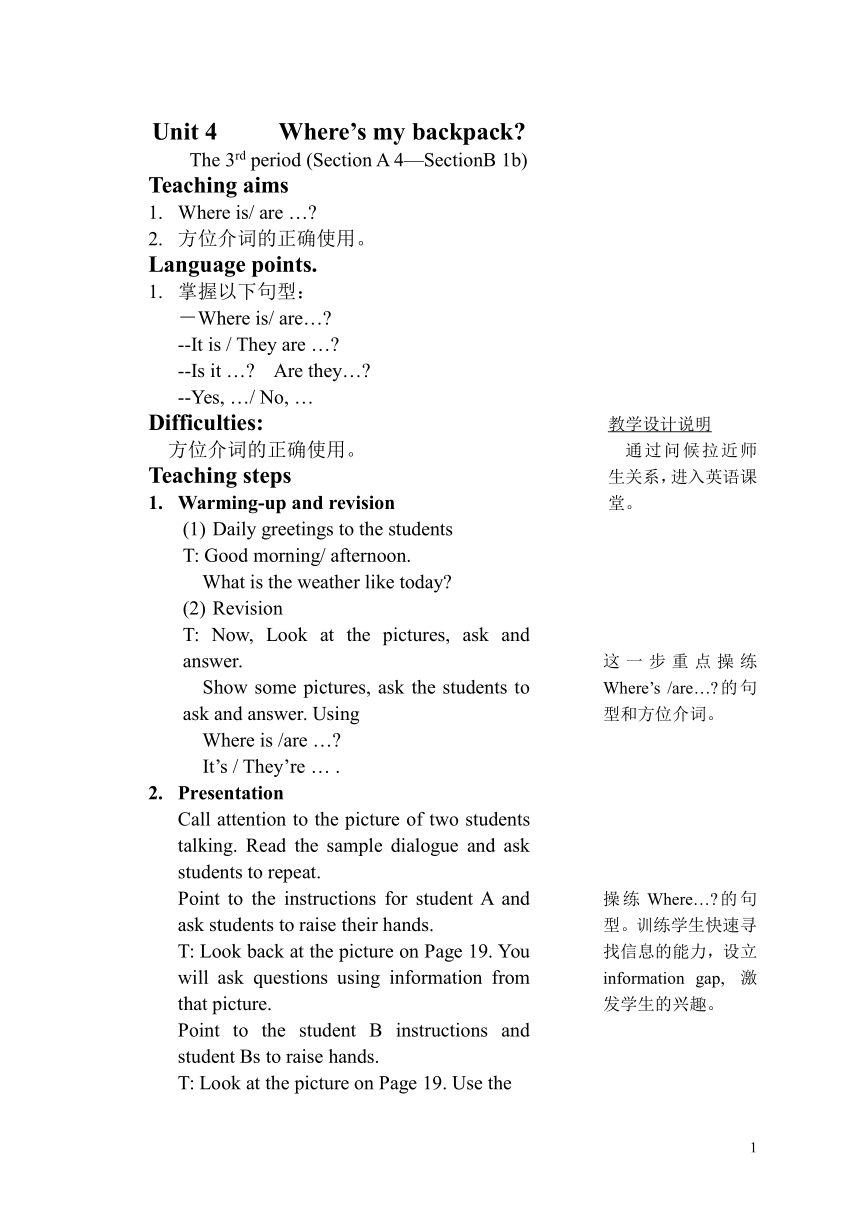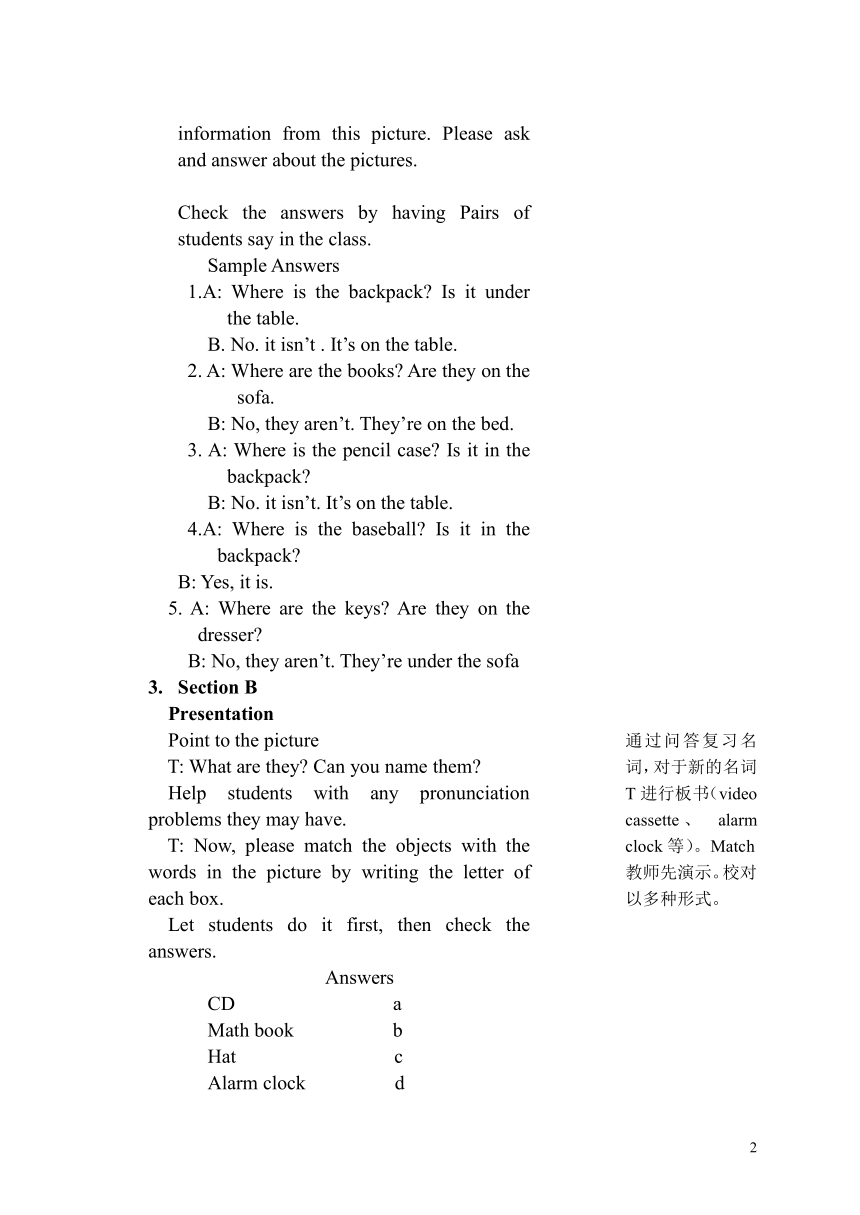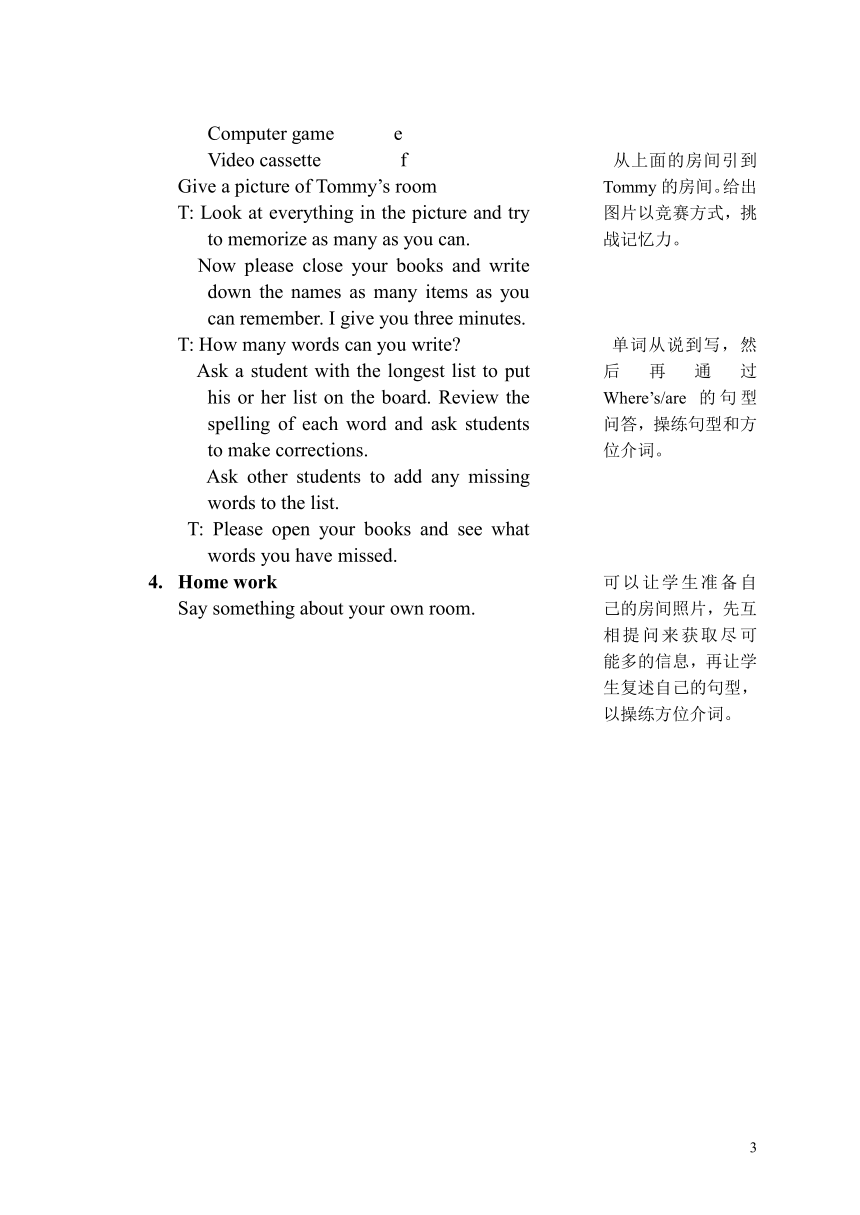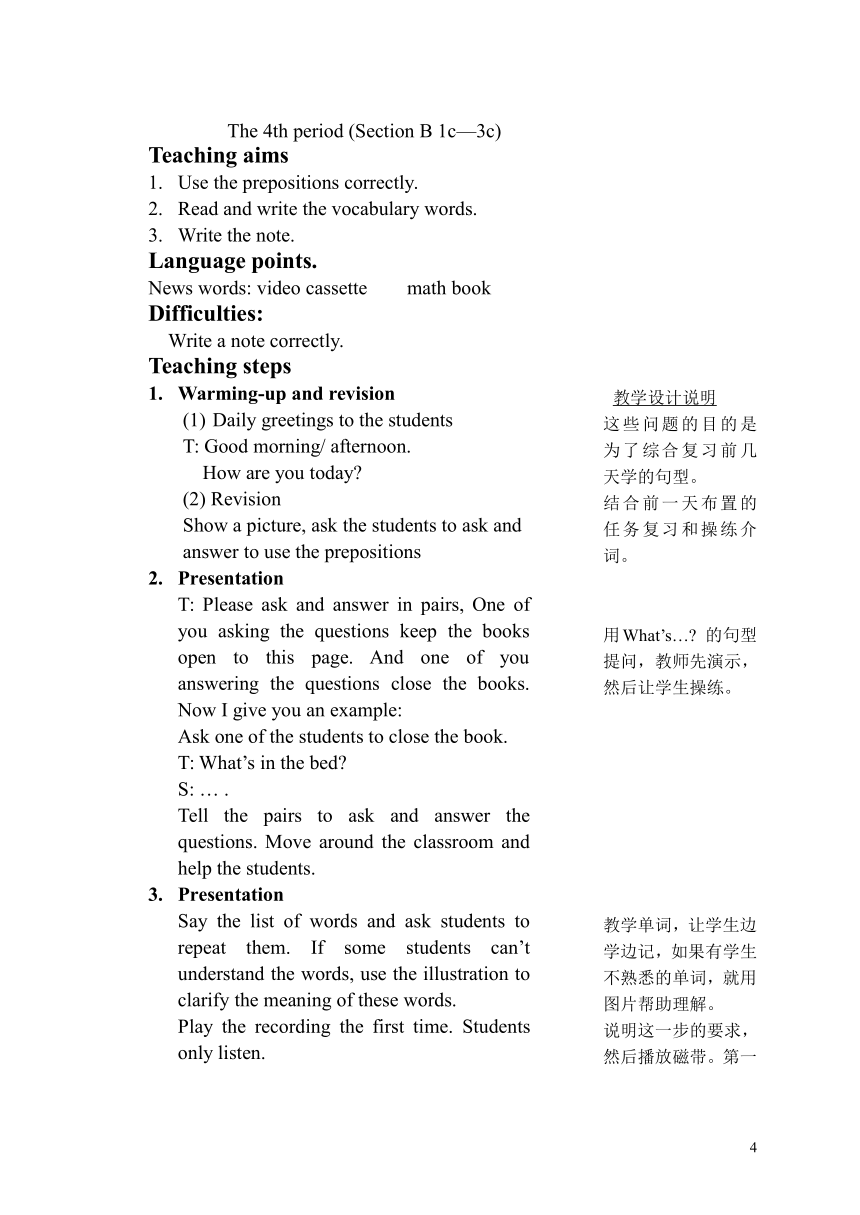七年级[上学期]Unit 4 Where is my backpack?
文档属性
| 名称 | 七年级[上学期]Unit 4 Where is my backpack? |  | |
| 格式 | rar | ||
| 文件大小 | 14.2KB | ||
| 资源类型 | 教案 | ||
| 版本资源 | 人教新目标(Go for it)版 | ||
| 科目 | 英语 | ||
| 更新时间 | 2007-10-31 14:01:00 | ||
图片预览




文档简介
Unit 4 Where’s my backpack
The 3rd period (Section A 4—SectionB 1b)
Teaching aims
1. Where is/ are …
2. 方位介词的正确使用。
Language points.
1. 掌握以下句型:
-Where is/ are…
--It is / They are …
--Is it … Are they…
--Yes, …/ No, …
Difficulties:
方位介词的正确使用。
Teaching steps
1. Warming-up and revision
(1) Daily greetings to the students
T: Good morning/ afternoon.
What is the weather like today
(2) Revision
T: Now, Look at the pictures, ask and answer.
Show some pictures, ask the students to ask and answer. Using
Where is /are …
It’s / They’re … .
2. Presentation
Call attention to the picture of two students talking. Read the sample dialogue and ask students to repeat.
Point to the instructions for student A and ask students to raise their hands.
T: Look back at the picture on Page 19. You will ask questions using information from that picture.
Point to the student B instructions and student Bs to raise hands.
T: Look at the picture on Page 19. Use the
教学设计说明
通过问候拉近师生关系,进入英语课堂。
这一步重点操练Where’s /are… 的句型和方位介词。
操练Where… 的句型。训练学生快速寻找信息的能力,设立information gap, 激发学生的兴趣。
information from this picture. Please ask and answer about the pictures.
Check the answers by having Pairs of students say in the class.
Sample Answers
1.A: Where is the backpack Is it under the table.
B. No. it isn’t . It’s on the table.
2. A: Where are the books Are they on the sofa.
B: No, they aren’t. They’re on the bed.
3. A: Where is the pencil case Is it in the backpack
B: No. it isn’t. It’s on the table.
4.A: Where is the baseball Is it in the backpack
B: Yes, it is.
5. A: Where are the keys Are they on the dresser
B: No, they aren’t. They’re under the sofa
3. Section B
Presentation
Point to the picture
T: What are they Can you name them
Help students with any pronunciation problems they may have.
T: Now, please match the objects with the words in the picture by writing the letter of each box.
Let students do it first, then check the answers.
Answers
CD a
Math book b
Hat c
Alarm clock d
通过问答复习名 词,对于新的名词T进行板书(video cassette、 alarm clock等)。Match教师先演示。校对以多种形式。
Computer game e
Video cassette f
Give a picture of Tommy’s room
T: Look at everything in the picture and try to memorize as many as you can.
Now please close your books and write down the names as many items as you can remember. I give you three minutes.
T: How many words can you write
Ask a student with the longest list to put his or her list on the board. Review the spelling of each word and ask students to make corrections.
Ask other students to add any missing words to the list.
T: Please open your books and see what words you have missed.
4. Home work
Say something about your own room.
从上面的房间引到Tommy的房间。给出图片以竞赛方式,挑战记忆力。
单词从说到写,然后再通过Where’s/are 的句型问答,操练句型和方位介词。
可以让学生准备自己的房间照片,先互相提问来获取尽可能多的信息,再让学生复述自己的句型,以操练方位介词。
The 4th period (Section B 1c—3c)
Teaching aims
1. Use the prepositions correctly.
2. Read and write the vocabulary words.
3. Write the note.
Language points.
News words: video cassette math book
Difficulties:
Write a note correctly.
Teaching steps
1. Warming-up and revision
(1) Daily greetings to the students
T: Good morning/ afternoon.
How are you today
(2) Revision
Show a picture, ask the students to ask and
answer to use the prepositions
2. Presentation
T: Please ask and answer in pairs, One of you asking the questions keep the books open to this page. And one of you answering the questions close the books. Now I give you an example:
Ask one of the students to close the book.
T: What’s in the bed
S: … .
Tell the pairs to ask and answer the questions. Move around the classroom and help the students.
3. Presentation
Say the list of words and ask students to repeat them. If some students can’t understand the words, use the illustration to clarify the meaning of these words.
Play the recording the first time. Students only listen.
教学设计说明
这些问题的目的是为了综合复习前几天学的句型。
结合前一天布置的任务复习和操练介词。
用What’s… 的句型提问,教师先演示,然后让学生操练。
教学单词,让学生边学边记,如果有学生不熟悉的单词,就用图片帮助理解。
说明这一步的要求,然后播放磁带。第一
Play the recording a second time.
T: Listen carefully and circle the things that Tommy wants from his room.
Answers: math book; ruler; notebook; CDs; video cassette.
T: Listen it again and try to finish the note, do it like the example.
Answers:
The math book is on the dresser.
The ruler is under the bed.
The notebook is on the bed.
The CDs are on the bookcase.
The video cassette is on the table.
4. Presentation
T: Now there is another note. Please read it and circle the names of the things.
Ask one of the students to read out the names of the things.
T: Elicit the names of items in the picture and where they are. Please use the prepositions correctly.
T: Now look carefully which is missing in the picture. Please draw them in the picture.
Check the answers.
Practice
T: After reading the note from Tommy, Sally wants to give a note to Tommy. Let’s look and help her. Look at the picture and name the items and tell me where they are.
Call attention to the gap-fill exercise. Read the sample answer to the class. E.g. Point to the hat and say it is on the chair.
Ask students to finish filling in the blanks
遍听并熟悉读音。第二遍听并完成任务,圈出有关单词。
再听一遍,尽量复述句子,并完成2b部分。如有必要,可让学生小组讨论,再检验答案。检验答案时,先有教师给出问句,再由学生回答。
阅读note,获取信息。要求学生通过阅读说出物品的名字以复习所学名词。再由教师提问Where… 让学生回答以操练方位介词。通过以上两步,帮助学生找到被遗漏的东西。
总结上面两个note 教师说明如何写note。要求学生帮助Sally完成note。先让学生说出图片中的东西并能用It’s…/They’re… 的句型说出这些东西的位置,然后再填空。
on their own. And check the answers.
Answers
My hat is on the chair.
The notebook is on the floor and my pen is on the table.
5. Writing
Tell the students hoe to write a note, and give them an example in 3b. tell them to use it as a model for their own letters.
Move around the classroom to help them.
Ask some students to read their letters to their partner.
Correct any mistakes in spelling or the using of the prepositions. Pay attention to the words in; on; and under.
6. Homework
On Page 24 3 Read the note and draw the room.
以前面三个note为例,提供一些信息,用板书呈现。先让学生说出句子,然后再写。教师及时给予帮助。
请几个学生展示他们的成果,并给予及时的评价和鼓励。
结合学生生活,并有利于拓展思维。
The 5th period (Section B4—Self Check)
Teaching aims(教学目标)
要求学生用已学的语言知识来设计自己理想的房间,并绘制成图,进行交流。
Language points(语言点)
1. 要求复习并运用以下词汇:
(1) 名词:table, bed, dresser, plant, alarm, picture, TV, desk, bag, bookcase, sofa, chair, drawer, hat, bag, math, alarm, video cassette
(2) 介词:on , in, under.
2. 要求运用1-4课时所学句式:
Teaching steps:
I.Warming-up and revision
1.Daily greeting to the students
T:What’s your name
S1:My name is….
T:Nice to meet you.
S2:Nice to meet you ,too.
T:What’s your name
S2:My name is ….
T:How are you
S2:Fine,thank you. And you (What about you )
T:I’m fine,too. How is the weather today
S2:It’s good / beautiful.
2.Revision
Make dialogues in pairs.(根据学生桌面的物品编对话)
1.----Where is your…
---It’s on / in / under the….
2.---Are these books in the backpack
---No,they aren’t. They are on the….
II. Draw an ideal room and describe it to your classmates.
Name of the task:An ideal room
Form:four students as a group
教学设计说明
这一步主要是复习日常问候和进行课前热身。
两个问题的设计主要是复习了方位词的一般疑问句和特殊疑问句式。设计自己的房间是每一个学生十分喜欢的活动。通过这
Teaching Procedures:The teacher gives a simple picture of a room.
1、Find the things which are needed.
2、Draw an ideal room in groups.
3、Show the pictures.
Each groups one speaker, and describe the ideal room in English.
eg:Here is my ideal room. My bed is …… Some books……
III. Make a short report.
Show a picture of a room,and guide the students to put the things in his own way.
(What’s this in English It’s a….Where would you like to put them Please put the things in order in your own way and then report it to the class.)
IV. Do the game Just for fun!
Revise “Where’s…. It’s…., Is it….. Yes, it is. No, it isn’t…”
Teaching procedures:
1)The teacher put a piece of cloth on a student’s eyes. The other student hides something quickly.
2) Let the first student guess the place of the thing by asking “Is it in /under/behind/on… Are they next to …?” Three times the most.
3)Other students answer “Yes/No”.
一方式,使学生在运用语言的过程中掌握家居物品及方位名词的表达。
通过这一步,使学生掌握would you like to…和祈使句的正确使用。
游戏的方式可以活跃课堂气氛,寓教于乐。学生们十分喜欢,并能积极参与。这个游戏的主旨是让学生使用方位名词的特殊疑问句、一般疑问句及肯定、否定回答。
V. Guide the students to draw the picture according to the Note.
Say: Here is a note from Eric. Please read it and draw the room.
We have learned all these words in this unit. Can you remember all the words
Read the words and check the words you know and write the Chinese meaning down. Now please check yourself. Let’s find out who remembers most.
VI.. Write new words in the Vocab-Builders.
You can say:
How many new words do you learn and remember in this unit but not in the book
Who learns and remembers the most new words in our class
Congratulations!
VII.Homework
Revise the words and dialogues in Unit 4.
这个练习将上面口头的练习落实到笔头。检查了学生单词的掌握状况。
这一步骤可以帮助学生将瞬间记忆变为长时记忆,并帮助学生从初一开始培养好良好的学习习惯。
PAGE
8
The 3rd period (Section A 4—SectionB 1b)
Teaching aims
1. Where is/ are …
2. 方位介词的正确使用。
Language points.
1. 掌握以下句型:
-Where is/ are…
--It is / They are …
--Is it … Are they…
--Yes, …/ No, …
Difficulties:
方位介词的正确使用。
Teaching steps
1. Warming-up and revision
(1) Daily greetings to the students
T: Good morning/ afternoon.
What is the weather like today
(2) Revision
T: Now, Look at the pictures, ask and answer.
Show some pictures, ask the students to ask and answer. Using
Where is /are …
It’s / They’re … .
2. Presentation
Call attention to the picture of two students talking. Read the sample dialogue and ask students to repeat.
Point to the instructions for student A and ask students to raise their hands.
T: Look back at the picture on Page 19. You will ask questions using information from that picture.
Point to the student B instructions and student Bs to raise hands.
T: Look at the picture on Page 19. Use the
教学设计说明
通过问候拉近师生关系,进入英语课堂。
这一步重点操练Where’s /are… 的句型和方位介词。
操练Where… 的句型。训练学生快速寻找信息的能力,设立information gap, 激发学生的兴趣。
information from this picture. Please ask and answer about the pictures.
Check the answers by having Pairs of students say in the class.
Sample Answers
1.A: Where is the backpack Is it under the table.
B. No. it isn’t . It’s on the table.
2. A: Where are the books Are they on the sofa.
B: No, they aren’t. They’re on the bed.
3. A: Where is the pencil case Is it in the backpack
B: No. it isn’t. It’s on the table.
4.A: Where is the baseball Is it in the backpack
B: Yes, it is.
5. A: Where are the keys Are they on the dresser
B: No, they aren’t. They’re under the sofa
3. Section B
Presentation
Point to the picture
T: What are they Can you name them
Help students with any pronunciation problems they may have.
T: Now, please match the objects with the words in the picture by writing the letter of each box.
Let students do it first, then check the answers.
Answers
CD a
Math book b
Hat c
Alarm clock d
通过问答复习名 词,对于新的名词T进行板书(video cassette、 alarm clock等)。Match教师先演示。校对以多种形式。
Computer game e
Video cassette f
Give a picture of Tommy’s room
T: Look at everything in the picture and try to memorize as many as you can.
Now please close your books and write down the names as many items as you can remember. I give you three minutes.
T: How many words can you write
Ask a student with the longest list to put his or her list on the board. Review the spelling of each word and ask students to make corrections.
Ask other students to add any missing words to the list.
T: Please open your books and see what words you have missed.
4. Home work
Say something about your own room.
从上面的房间引到Tommy的房间。给出图片以竞赛方式,挑战记忆力。
单词从说到写,然后再通过Where’s/are 的句型问答,操练句型和方位介词。
可以让学生准备自己的房间照片,先互相提问来获取尽可能多的信息,再让学生复述自己的句型,以操练方位介词。
The 4th period (Section B 1c—3c)
Teaching aims
1. Use the prepositions correctly.
2. Read and write the vocabulary words.
3. Write the note.
Language points.
News words: video cassette math book
Difficulties:
Write a note correctly.
Teaching steps
1. Warming-up and revision
(1) Daily greetings to the students
T: Good morning/ afternoon.
How are you today
(2) Revision
Show a picture, ask the students to ask and
answer to use the prepositions
2. Presentation
T: Please ask and answer in pairs, One of you asking the questions keep the books open to this page. And one of you answering the questions close the books. Now I give you an example:
Ask one of the students to close the book.
T: What’s in the bed
S: … .
Tell the pairs to ask and answer the questions. Move around the classroom and help the students.
3. Presentation
Say the list of words and ask students to repeat them. If some students can’t understand the words, use the illustration to clarify the meaning of these words.
Play the recording the first time. Students only listen.
教学设计说明
这些问题的目的是为了综合复习前几天学的句型。
结合前一天布置的任务复习和操练介词。
用What’s… 的句型提问,教师先演示,然后让学生操练。
教学单词,让学生边学边记,如果有学生不熟悉的单词,就用图片帮助理解。
说明这一步的要求,然后播放磁带。第一
Play the recording a second time.
T: Listen carefully and circle the things that Tommy wants from his room.
Answers: math book; ruler; notebook; CDs; video cassette.
T: Listen it again and try to finish the note, do it like the example.
Answers:
The math book is on the dresser.
The ruler is under the bed.
The notebook is on the bed.
The CDs are on the bookcase.
The video cassette is on the table.
4. Presentation
T: Now there is another note. Please read it and circle the names of the things.
Ask one of the students to read out the names of the things.
T: Elicit the names of items in the picture and where they are. Please use the prepositions correctly.
T: Now look carefully which is missing in the picture. Please draw them in the picture.
Check the answers.
Practice
T: After reading the note from Tommy, Sally wants to give a note to Tommy. Let’s look and help her. Look at the picture and name the items and tell me where they are.
Call attention to the gap-fill exercise. Read the sample answer to the class. E.g. Point to the hat and say it is on the chair.
Ask students to finish filling in the blanks
遍听并熟悉读音。第二遍听并完成任务,圈出有关单词。
再听一遍,尽量复述句子,并完成2b部分。如有必要,可让学生小组讨论,再检验答案。检验答案时,先有教师给出问句,再由学生回答。
阅读note,获取信息。要求学生通过阅读说出物品的名字以复习所学名词。再由教师提问Where… 让学生回答以操练方位介词。通过以上两步,帮助学生找到被遗漏的东西。
总结上面两个note 教师说明如何写note。要求学生帮助Sally完成note。先让学生说出图片中的东西并能用It’s…/They’re… 的句型说出这些东西的位置,然后再填空。
on their own. And check the answers.
Answers
My hat is on the chair.
The notebook is on the floor and my pen is on the table.
5. Writing
Tell the students hoe to write a note, and give them an example in 3b. tell them to use it as a model for their own letters.
Move around the classroom to help them.
Ask some students to read their letters to their partner.
Correct any mistakes in spelling or the using of the prepositions. Pay attention to the words in; on; and under.
6. Homework
On Page 24 3 Read the note and draw the room.
以前面三个note为例,提供一些信息,用板书呈现。先让学生说出句子,然后再写。教师及时给予帮助。
请几个学生展示他们的成果,并给予及时的评价和鼓励。
结合学生生活,并有利于拓展思维。
The 5th period (Section B4—Self Check)
Teaching aims(教学目标)
要求学生用已学的语言知识来设计自己理想的房间,并绘制成图,进行交流。
Language points(语言点)
1. 要求复习并运用以下词汇:
(1) 名词:table, bed, dresser, plant, alarm, picture, TV, desk, bag, bookcase, sofa, chair, drawer, hat, bag, math, alarm, video cassette
(2) 介词:on , in, under.
2. 要求运用1-4课时所学句式:
Teaching steps:
I.Warming-up and revision
1.Daily greeting to the students
T:What’s your name
S1:My name is….
T:Nice to meet you.
S2:Nice to meet you ,too.
T:What’s your name
S2:My name is ….
T:How are you
S2:Fine,thank you. And you (What about you )
T:I’m fine,too. How is the weather today
S2:It’s good / beautiful.
2.Revision
Make dialogues in pairs.(根据学生桌面的物品编对话)
1.----Where is your…
---It’s on / in / under the….
2.---Are these books in the backpack
---No,they aren’t. They are on the….
II. Draw an ideal room and describe it to your classmates.
Name of the task:An ideal room
Form:four students as a group
教学设计说明
这一步主要是复习日常问候和进行课前热身。
两个问题的设计主要是复习了方位词的一般疑问句和特殊疑问句式。设计自己的房间是每一个学生十分喜欢的活动。通过这
Teaching Procedures:The teacher gives a simple picture of a room.
1、Find the things which are needed.
2、Draw an ideal room in groups.
3、Show the pictures.
Each groups one speaker, and describe the ideal room in English.
eg:Here is my ideal room. My bed is …… Some books……
III. Make a short report.
Show a picture of a room,and guide the students to put the things in his own way.
(What’s this in English It’s a….Where would you like to put them Please put the things in order in your own way and then report it to the class.)
IV. Do the game Just for fun!
Revise “Where’s…. It’s…., Is it….. Yes, it is. No, it isn’t…”
Teaching procedures:
1)The teacher put a piece of cloth on a student’s eyes. The other student hides something quickly.
2) Let the first student guess the place of the thing by asking “Is it in /under/behind/on… Are they next to …?” Three times the most.
3)Other students answer “Yes/No”.
一方式,使学生在运用语言的过程中掌握家居物品及方位名词的表达。
通过这一步,使学生掌握would you like to…和祈使句的正确使用。
游戏的方式可以活跃课堂气氛,寓教于乐。学生们十分喜欢,并能积极参与。这个游戏的主旨是让学生使用方位名词的特殊疑问句、一般疑问句及肯定、否定回答。
V. Guide the students to draw the picture according to the Note.
Say: Here is a note from Eric. Please read it and draw the room.
We have learned all these words in this unit. Can you remember all the words
Read the words and check the words you know and write the Chinese meaning down. Now please check yourself. Let’s find out who remembers most.
VI.. Write new words in the Vocab-Builders.
You can say:
How many new words do you learn and remember in this unit but not in the book
Who learns and remembers the most new words in our class
Congratulations!
VII.Homework
Revise the words and dialogues in Unit 4.
这个练习将上面口头的练习落实到笔头。检查了学生单词的掌握状况。
这一步骤可以帮助学生将瞬间记忆变为长时记忆,并帮助学生从初一开始培养好良好的学习习惯。
PAGE
8
同课章节目录
- starters 预备篇(2012秋审查)
- Unit 1 Good morning !
- Unit 2 What’s this in English?
- Unit 3 What color is it ?
- Unit 1 My name's Gina.
- Section A
- Section B
- Unit 2 This is my sister.
- Section A
- Section B
- Unit 3 Is this your pencil?
- Section A
- Section B
- Unit 4 Where's my schoolbag?
- Section A
- Section B
- Unit 5 Do you have a soccer ball?
- Section A
- Section B
- Unit 6 Do you like bananas?
- Section A
- Section B
- Unit 7 How much are these socks?
- Section A
- Section B
- Unit 8 When is your birthday?
- Section A
- Section B
- Unit 9 My favorite subject is science.
- Section A
- Section B
